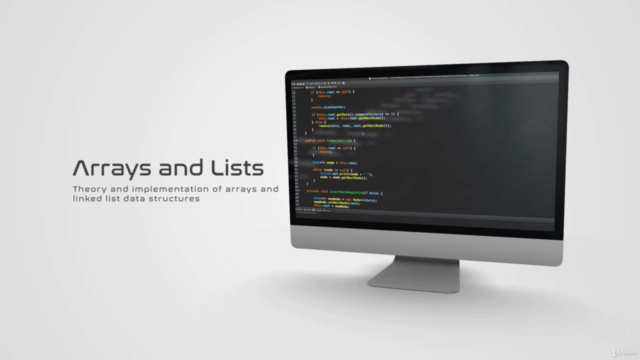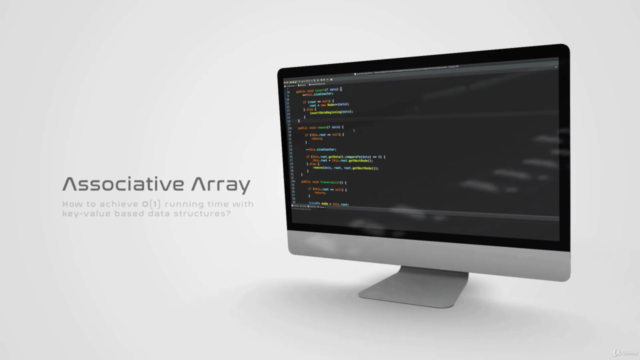Algorithms Data Structures in Java #1 (+INTERVIEW QUESTIONS)

Why take this course?
🌟 Course Title: Algorithms and Data Structures in Java #1
🚀 Course Overview:
Dive into the world of algorithms and data structures with our comprehensive Java course. This journey will take approximately 20 hours as you explore fundamental concepts and practical implementations. Master abstract data types, arrays, linked lists, stacks, queues, binary search trees, AVL trees, red-black trees, splay trees, heaps, B-trees, hashing, hashmaps, sorting algorithms, substring search algorithms, LRU caches, Fenwick trees, and more. Get ready to elevate your coding skills to a whole new level!
📚 Course Content Breakdown:
Section 1: Introduction to Data Structures and Abstract Data Types
- Understanding the fundamentals of data structures.
Section 2: Arrays
- What are arrays and how do they work?
- Exploring random access and array indexing.
Section 3: Linked Lists
- Unraveling the concepts behind linked lists and doubly linked lists.
- Common interview questions related to linked lists.
Section 4: Stacks and Queues
- The basics of stacks and queues, with a focus on memory management.
- Visualizing stack memory operations for a deeper understanding.
Section 5: Binary Search Trees (BSTs)
- Delving into tree data structures and their significance.
- Achieving logarithmic running time with binary search trees.
Section 6: AVL Trees
- Understanding the limitations of binary search trees and how AVL trees overcome them.
- Learning about rotations within AVL trees.
Section 7: Red-Black Trees
- Exploring what red-black trees are and their use cases.
- Implementing red-black trees for balanced tree operations.
Section 8: Splay Trees
- Introduction to splay trees and their self-balancing properties.
- Hands-on implementation of splay trees.
Section 9: Heaps
- Understanding heap data structures and their application in priority queues.
- Implementing heaps in Java.
Section 10: B-Trees
- Learning about the storage structure of B-trees.
- Analyzing how B-trees are used for database indexing and file systems.
Section 11: Hashing and Hashmaps
- Understanding hashing techniques and their role in data retrieval.
- Implementing hashmaps for efficient key-value storage.
Section 12 (BONUS): LRU Cache Implementation
- Leveraging least recently used (LRU) caches to optimize data access.
Section 13 (BONUS): Fenwick Trees (Binary Indexed Trees)
- Discovering the use of binary indexed trees for efficient range sum queries.
Section 14: Algorithms Analysis
- Learning how to measure and analyze the running time of algorithms.
- Exploring complexity classes and various running time complexities.
🔍 Real-World Applications:
These data structures and algorithms form the backbone of many applications in investment banking, artificial intelligence, electronic trading on the stock market, and beyond. Understanding their principles is crucial for applying them effectively in real-world scenarios.
🧩 What You Will Learn:
- The theoretical background of each algorithm or data structure.
- Step-by-step coding implementation in Eclipse with Java.
- How to analyze the running time and complexity of algorithms.
🚀 Why Enroll?
- Industry Relevance: Gain skills that are highly sought after in tech and financial industries.
- Versatile Skills: Apply what you learn across multiple domains, from finance to AI.
- Practical Experience: Code your way through each concept with hands-on Java projects.
🎓 Join Us on This Journey!
Let's embark on this coding adventure together and unlock the power of algorithms and data structures in Java. Sign up now to transform your understanding of complex problems and become a proficient programmer in no time!
🛠️ Tools & Technologies:
- Java: Our primary language for coding exercises.
- Eclipse IDE: The development environment where you'll write your code.
🤔 Frequently Asked Questions (FAQs):
- Q: What is the expected time commitment for this course?
- A: Typically, students spend around 20 hours to complete the course content and exercises.
- Q: Do I need prior programming experience to take this course?
- A: While familiarity with basic programming concepts is beneficial, this course is designed for learners of all levels who are eager to dive into data structures and algorithms with Java.
- Q: Are there any additional resources or materials provided with the course?
- A: Yes, you will receive supplementary resources, including code examples, best practices, and links to further reading on each topic.
📢 Stay Connected:
Join our community of learners for support, discussion, and networking opportunities. Our online forum is a great place to ask questions, share your progress, and connect with peers and instructors.
🎟️ Enroll Now to Secure Your Spot!
Take the first step towards mastering algorithms and data structures in Java. Enroll today and unlock new opportunities in your programming journey!
Course Gallery




Loading charts...